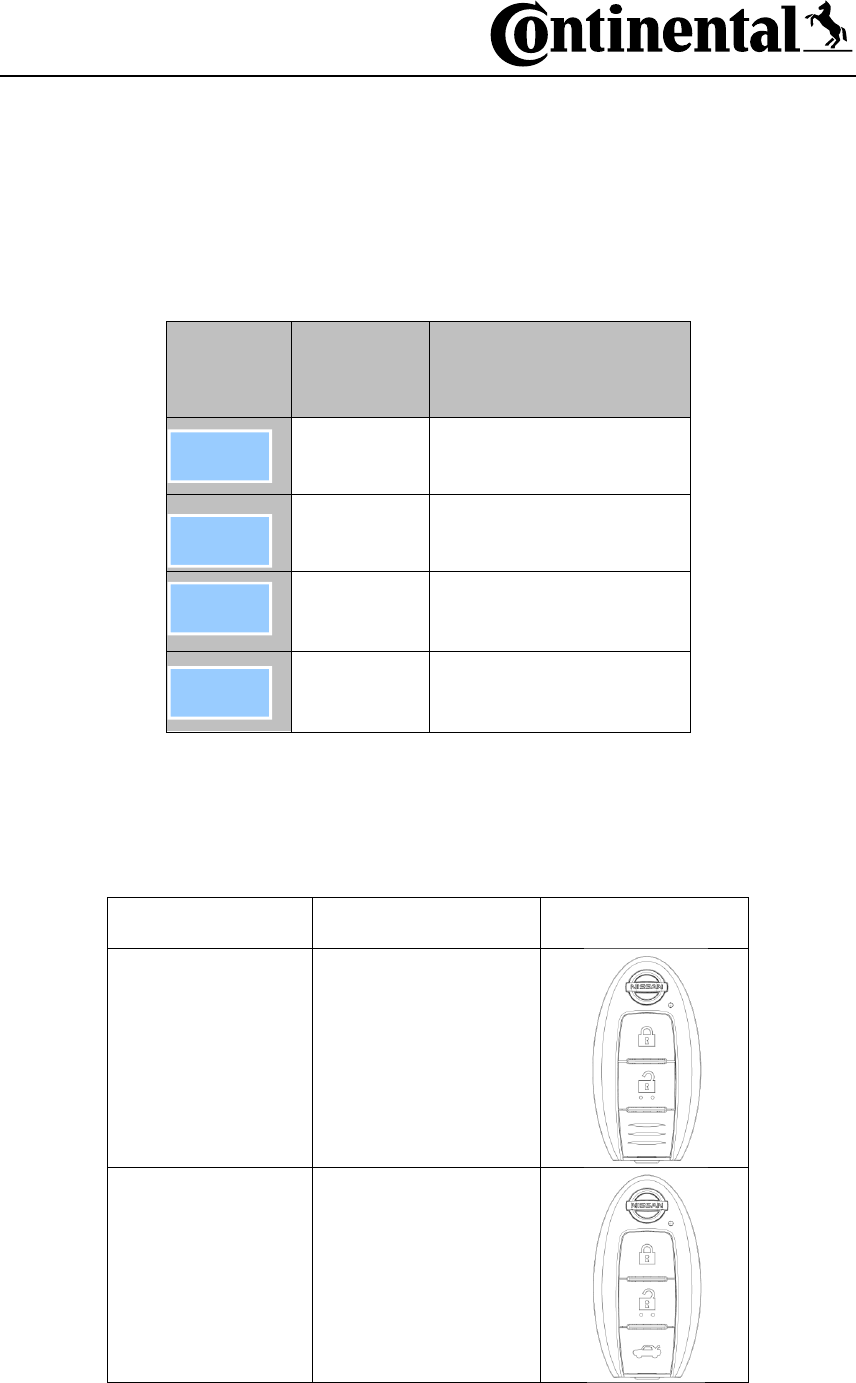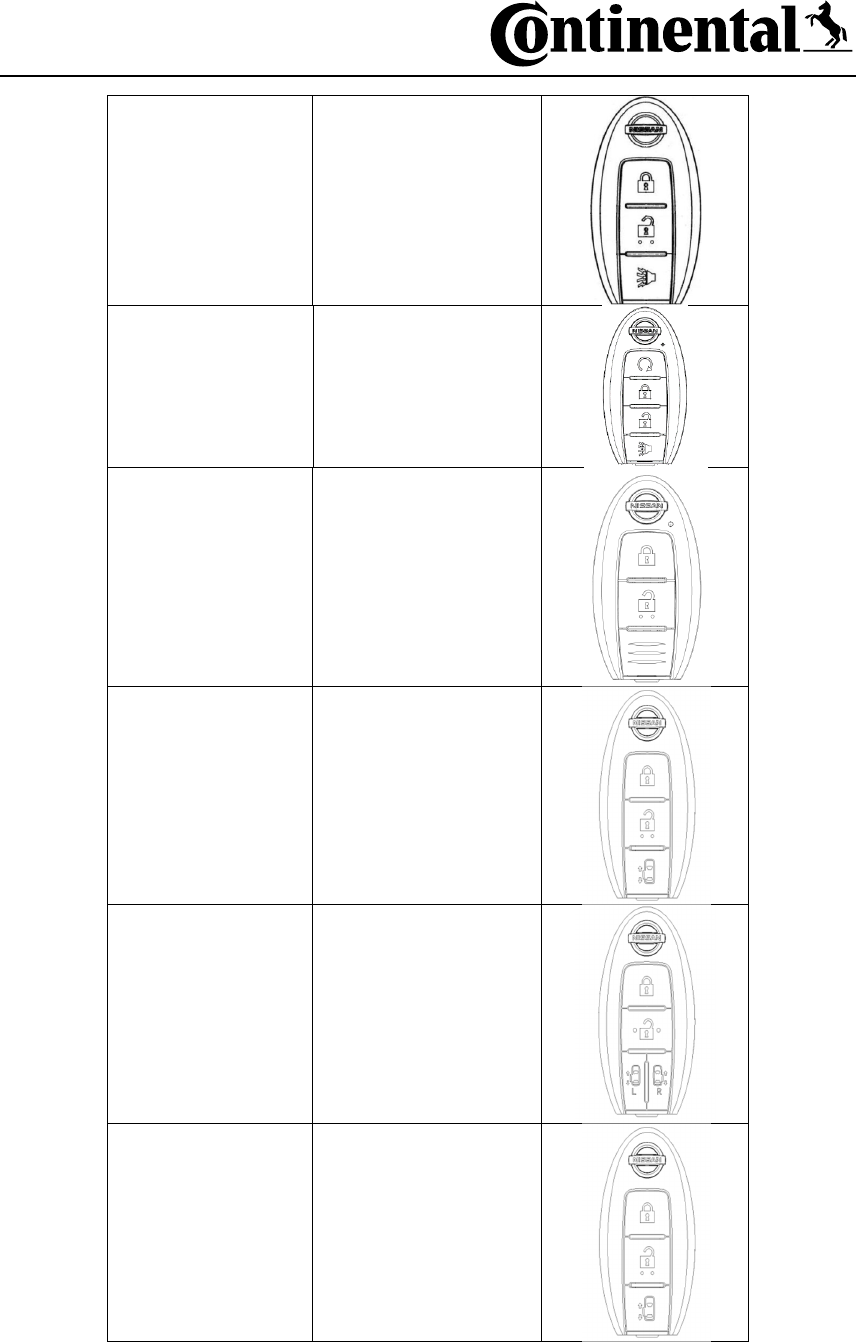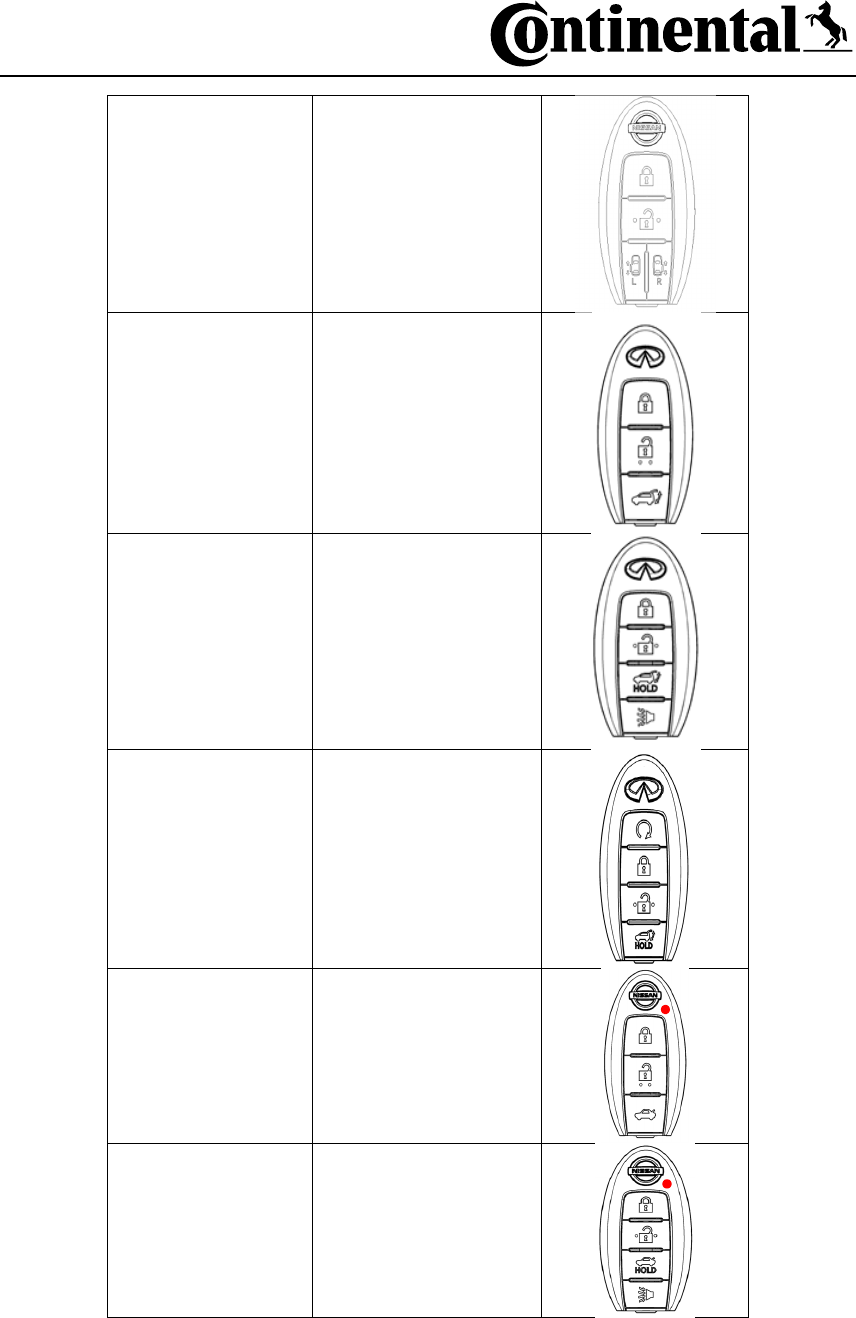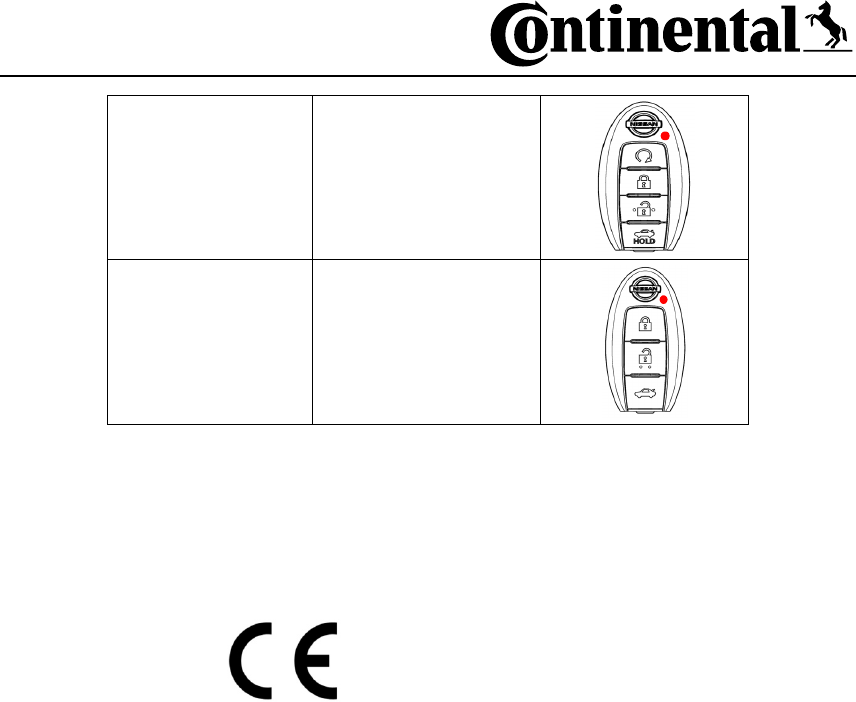Continental Automotive TXN3 Radio Frequency Transmitter User Manual User manual model TXN3 keyfob V1
Continental Automotive GmbH Radio Frequency Transmitter User manual model TXN3 keyfob V1
User manual

Continental Automotive France SAS
Interior Division- Body & Security
-1-
October 16, 2017
User Manual
of the
Continental
Radio Frequency Transmitter
Model:
TXN3 (433.92 MHz)

Continental Automotive France SAS
Interior Division- Body & Security
-2-
October 16, 2017
UsermanualoftheTXN3key
1 General Product Information
This document gives an overview of the different device operation modes and the RF transmissions
performance of the key model TXN3. In this document the device is referenced as "key", even if the
mechanical backup key might be separated from it.
1.1 Trade mark
Continental
1.2 Brand
Continental
1.3 Manufacturer
Continental Automotive GmbH
Siemensstr. 12
93055 Regensburg
Germany

Continental Automotive France SAS
Interior Division- Body & Security
-3-
October 16, 2017
2 Operating modes
The key has three main operating modes which differ regarding of the signal transmitting with the
RF:
• Immo Immobilizer transponder mode
• RKE Remote keyless functionality
• PASE Passive key functionality
2.1 Immobilizer Transponder mode
When the key is operating as an immobilizer transponder, the communication is done via a "contact less
interface" depending on a magnetic coupling.
2.2 Remote keyless functionality
This mode refers to use the key as a remote control unit to initiate actions on the vehicle such as open
or close door latches. RF transmission depends on a user activating (a button pressing) on the key.
During the button pressing the amount of telegrams are sent on the RF channel at 433.92 MHz.
A short valid button pressing results a sending of the minimum number of the RF telegrams.
If the duration of the button pressing extents the time required for transmitting the minimum amount of
RF telegrams, additional telegrams will be sent until the button is released or a timeout of 10s is reached.
This timeout function prevents the unintended transmission over the extended time periods in case of a
button was fixed.
2.3 Passive key functionality
For passive key operation no user action on the key side is required. The trigger is delivered by the
vehicle via an LF 125 kHz data telegram. When the key receives a valid LF message, it responds with
two RF telegrams and the inter telegram timing in this mode depends on the key configuration data (sort
of time slot concept).
The Low Frequency stage operates at 125 kHz.

Continental Automotive France SAS
Interior Division- Body & Security
-4-
October 16, 2017
3 Button functions
The validation of the accurate frequency deviation and the measurement of the transmission function of
the key are implemented basing on RF test software. The graphic below shows the functionality of the
buttons.
First Button
press
Press and hold button
Lock vehicle Comfort Close
Unlock vehicle Comfort Open
Open trunk Open trunk
Alarm
signaling Alarm signaling
4 Key fobs Variants
Product reference
Product variant Drawing
S180144500 Lock/Unlock
433.92 MHz
S180144501
Lock/Unlock/Trunk
433.92 MHz
Button
Lock
Button
UnLock
Button
Trunk
Button
Panic

Continental Automotive France SAS
Interior Division- Body & Security
-5-
October 16, 2017
S180144502 Lock/Unlock/Panic
433.92 MHz
S180144503 RES/Lock/Unlock/Panic
433.92 MHz
S180144600 Lock/Unlock
315 MHz
S180144601 Lock/Unlock/PSD-L
315 MHz
S180144602
Lock/Unlock/PSD-
L/PSD-R
315 MHz
S180144603 Lock/Unlock/PSD-L
433.92 MHz

Continental Automotive France SAS
Interior Division- Body & Security
-6-
October 16, 2017
S180144604
Lock/Unlock/PSD-
L/PSD-R
433.92 MHz
S180144700
Lock/Unlock/PBD
433.92 MHz
S180144701
Lock/Unlock/PBD/P
433.92 MHz
S180144702
RES/Lock/Unlock/PBD
433.92 MHz
S180144800 Lock/Unlock/ Trunk
433,92MHz
S180144801
Lock/Unlock/
Trunk/Panic
433,92MHz

Continental Automotive France SAS
Interior Division- Body & Security
-7-
October 16, 2017
S180144802 RES/Lock/ Unlock/Trunk
433,92MHz
S180144804 Lock/Unlock/ Trunk
315MHz
5 Product Label Information model TXN3
5.1 EC
Continental
Model: TXN3
5.2 USA/Canada
Continental
Model: TXN3
FCC ID: KR5TXN3
IC:7812D-TXN3
6 User Manual model TXN3
6.1 User Manual USA/Canada
FCC ID: KR5TXN3
IC:7812D–TXN3
This device complies with Part 15 of the FCC Rules and Industry Canada licence-exempt RSS
standard(s). Operation is subject to the following two conditions: (1) this device may not cause
interference, and (2) this device must accept any interference, including interference that may cause
undesired operation of the device.
Le présent appareil est conforme aux CNR d'Industrie Canada applicables aux appareils radio
exempts de licence. L'exploitation est autorisée aux deux conditions suivantes : (1) l'appareil ne doit

Continental Automotive France SAS
Interior Division- Body & Security
-8-
October 16, 2017
pas produire de brouillage, et (2) l'utilisateur de l'appareil doit accepter tout brouillage radioélectrique
subi, même si le brouillage est susceptible d'en compromettre le fonctionnement.
This device complies with FCC/IC radiation exposure limits set forth for an uncontrolled environment
and meets the FCC radio frequency (RF) Exposure Guidelines and RSS
‐
102 of the IC radio frequency
(RF) Exposure rules. This transmitter must not be co-located or operating in conjunction with any other
antenna or transmitter.
Le présent appareil est conforme à l'exposition aux radiations FCC / IC définies pour un
environnement non contrôlé et répond aux directives d'exposition de la fréquence de la FCC
radiofréquence (RF) et RSS
‐
102 de la fréquence radio (RF) IC règles d'exposition. L'émetteur ne doit
pas être colocalisé ni fonctionner conjointement avec à autre antenne ou autre émetteur.
This equipment has been tested and found to comply with the limits for a Class B digital device,
pursuant to part 15 of the FCC Rules. These limits are designed to provide reasonable protection
against harmful interference in a residential installation. This equipment generates, uses and can
radiate radio frequency energy and, if not installed and used in accordance with the instructions, may
cause harmful interference to radio communications. However, there is no guarantee that interference
will not occur in a particular installation. If this equipment does cause harmful interference to radio or
television reception, which can be determined by turning the equipment off and on, the user is
encouraged to try to correct the interference by one or more of the following measures:
- Reorient or relocate the receiving antenna.
- Increase the separation between the equipment and receiver.
- Connect the equipment into an outlet on a circuit different from that to which the receiver is
connected.
- Consult the dealer or an experienced radio/TV technician for help.
CAN ICES-3 (B) / NMB-3 (B)
This Class B digital apparatus complies with Canadian ICES-003.
Cet appareil numérique de classe B est conforme à la norme canadienne NMB-003.
Continental Automotive GmbH has not approved any changes or modifications to this device by the
user. Any changes or modifications could void the user’s authority to operate the equipment.
Continental Automotive GmbH
n’approuve aucune modification apportée à l’appareil par l’utilisateur,
quelle qu’en soit la nature. Tout changement ou modification peuvent annuler le droit d’utilisation de
l’appareil par l’utilisateur.